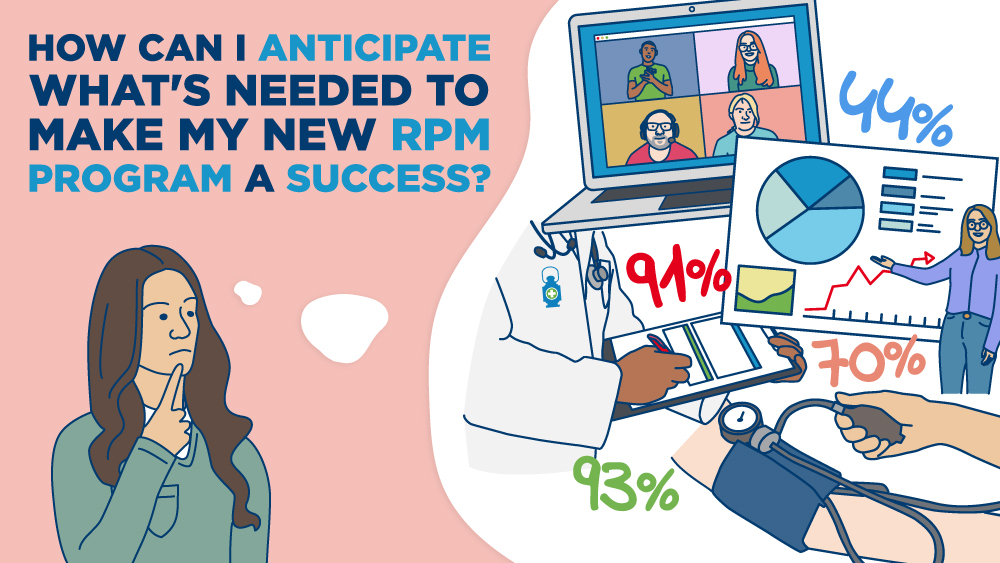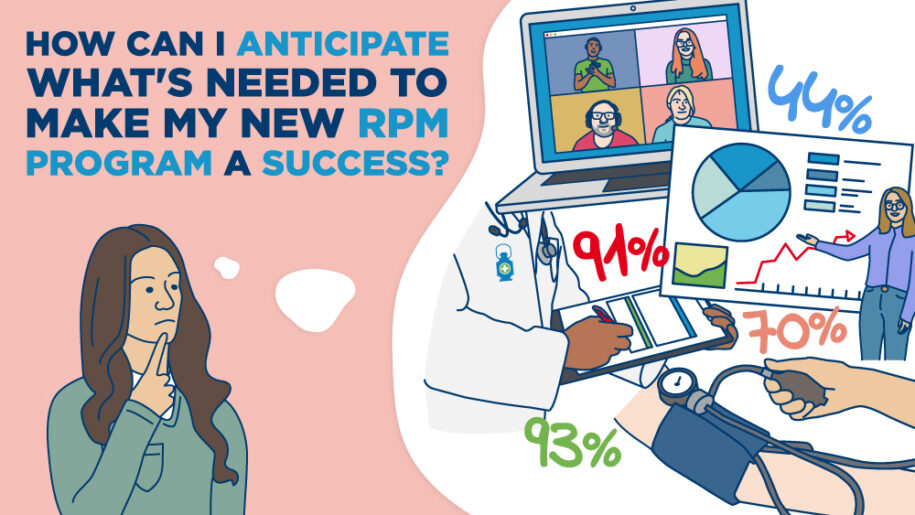
How Can I Anticipate What’s Needed to Make My New RPM Program a Success?
Remote patient monitoring (RPM) technology is in high demand as more healthcare providers and health systems search for better and more effective ways to care for patients. Business Insider estimates over 30 million patients in the United States will use RPM tools by 2024 to improve their health outcomes [1].
Despite these lofty projections, the reality is much different. A study of the claims made under the traditional Medicare RPM CPT codes found that these claims only increased from 91 per 100,000 enrollees in February 2020 to 594 for the same number of enrollees in September 2021 [2]. This means that even during the pandemic, which acted as a significant catalyst for remote technologies across all industries, there was still less than 1% of Medicare enrollees who had an RPM claim.
Comparing the relative differences in projected RPM usage to the practical adoption and patient compliance rates reveals gaps in implementing large-scale remote patient monitoring.
Why RPM Implementations Often Fail
There are many reasons why health systems and providers are not successful at implementing and/or scaling their RPM program. But in almost all cases, those reasons are the result of one common mistake:
A fundamental misunderstanding of the gap between what their RPM program looks like on paper and what will happen in reality once it’s implemented.
And while there are many, here are the top four false assumptions made by early RPM adopters:
1. Assumption: Once you enroll patients and ship them a device, getting the patient to consistently use their device month over month will require minimal effort from your care team.
→ In Reality: Devices will become paper weights if patients are not engaged with care management alongside the RPM program.
2. Assumption: Patients will understand how (and when) to properly take their reading based on literature that ships with the device, and only the patient will use the device.
→ In Reality: Patients will not understand how or when to record their readings. They might not know that they shouldn’t take their blood pressure when they just came in from walking their dog, or that when recording their weight, they need to step on the scale at the same time every day. Inevitably, spouses and grandkids will use the devices too, and there will be many false readings that need to be triaged by your care team.
3. Assumption: Your existing providers and care team have the capacity to incorporate RPM monitoring into their existing workflows.
→ In Reality: They do not. Your care team is already stretched thin. There will be no way to sustain your RPM program long term unless you add dedicated nurse care managers to support the program.
4. Assumption: Having your providers monitor and document RPM in a third-party platform outside their EMR will work.
→ In Reality: Providers will never consistently use a platform that is outside their EMR workflow.
Scaling an RPM Program Doesn’t Have to be Hard
Health systems have leveraged the Signallamp platform and unique model of care to successfully scale RPM programs and achieve outstanding long-term results, all with no out-of-pocket expense or upfront capital. The infographic below represents KPIs aggregated from Signallamp client RPM implementations:
Easily Implement RPM with Signallamp’s Scalable and Reliable Model
Like other high-impact healthcare programs, an RPM program requires methodical resource management and allocation to be successful.
At Signallamp, we have developed a robust RPM model that focuses on improving patient outcomes while minimizing pain points that typically hinder RPM programs from scaling, such as upfront costs, clinical capacity, logistics, and technology.
You can be more successful in value-based care and improve outcomes for your patients by helping them to avoid unnecessary trips to the ER and/or by being admitted to the hospital for preventable health concerns.
Schedule a consultation today to learn more about how you can tap into Signallamp’s unique platform and services to easily scale remote care programs like RPM & CCM.
Sources:
1 Business Insider. The Technology, Devices, and Benefits of Remote Patient Monitoring in the Healthcare Industry. https://www.businessinsider.com/10-4-2022-remote-patient-monitoring-industry-explained
2 Mobi Health News. Study: Medicare Remote Patient Monitoring Use Surges During Pandemic. https://www.mobihealthnews.com/news/study-medicare-remote-patient-monitoring-use-surges-during-pandemic
3 Mobi Health News. Study: Medicare Remote Patient Monitoring Use Surges During Pandemic. https://www.mobihealthnews.com/news/study-medicare-remote-patient-monitoring-use-surges-during-pandemic
4 Business Insider. The Technology, Devices, and Benefits of Remote Patient Monitoring in the Healthcare Industry. https://www.businessinsider.com/10-4-2022-remote-patient-monitoring-industry-explained
5 Business Insider. The Technology, Devices, and Benefits of Remote Patient Monitoring in the Healthcare Industry. https://www.businessinsider.com/10-4-2022-remote-patient-monitoring-industry-explained

